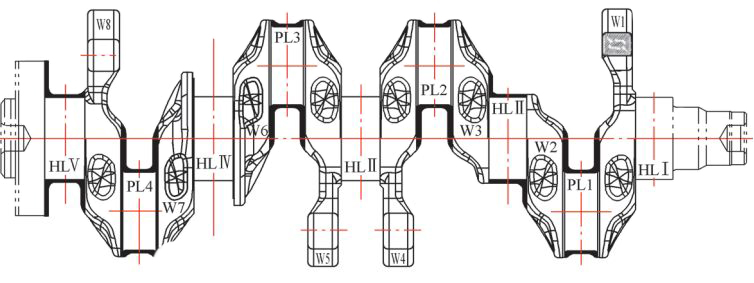Fillet quenching technology of crankshaft
2020-07-07
The crankshaft is one of the most important parts in the internal combustion engine, and its service life often determines the service life of the internal combustion engine. In 1920, the American Clark Company used the induction hardening technology that was invented recently for crankshaft journal hardening, which greatly improved the abrasion resistance of the crankshaft, thereby improving the working life of the internal combustion engine.

In recent decades, fatigue fractures of the crankshaft have become more prominent, and fatigue sources mostly occur at the rounded corners of the crankshaft of the connecting rod journal. For this reason, many manufacturers have proposed requirements to improve the fatigue strength of the crankshaft. The key to improving crankshaft fatigue strength is to increase the residual compressive stress of the crankshaft fillet. Induction hardening of crankshaft fillets (including journals) is the preferred method for obtaining large residual compressive stresses of >600MPa for fillets. A Japanese company conducted a series of bending fatigue tests on the internal combustion engine crankshaft. The experiment proved that the rounded induction hardened crankshaft has the highest fatigue strength (996MPa), the rounded rolled crankshaft fatigue strength is second (890MPa), and the nitrided crankshaft is third ( 720MPa). American companies also have similar data. Crankshaft fillet quenching generally uses "half-turn inductor" quenching, also known as the Elotherm (Elotherm) quenching method. It is that the sensor is buckled on the journal, and the crankshaft is heated and water quenched during rotation (there is also a case where the crankshaft journal is heated to the quenching temperature and then turned into the pool for cooling and quenching). This method not only facilitates the entry and exit of the crankshaft sensor, simplifies the action of the quenching machine tool, but also solves the oil hole cracks, the uneven width of the hardened area, the uneven thickness of the hardened layer Problems such as large deformation.
People in the industry generally believe that the Eluosen quenching method is a major advancement in crankshaft induction quenching technology. Data show that induction hardening of crankshaft journals can increase engine life to 8000 hours, while induction quenching of journals and fillets can increase engine life to 10,000 hours. The key technology that must be solved to achieve fillet quenching is power distribution technology. Crankshaft "half-turn inductor" quenching involves many technologies, such as frequency conversion power supply, quenching machine tool and inductor, etc. These technologies are also very important, but these technologies have been initially solved in my country in the early 1980s.
Obviously, the quenching heating of the crankshaft fillet should be carried out intact. The heating power of the inside of the crank and the outside of the crank should be changed, that is, the power of the inside of the crank should be large, and the power of the outside of the crank should be small. This technology is called power distribution technology. The rounded corners of large and small crankshafts are quenched. The technology is to provide 100% power when heating the inside of the crank, and 60% (or 70%) power when heating the outside of the crank, and as the crankshaft rotates, the angle increases (or decreases) by a certain amount every 15°The power.